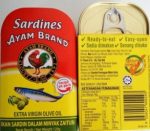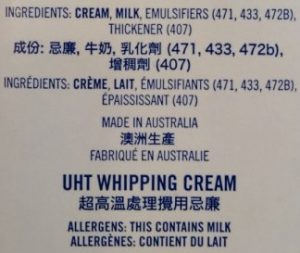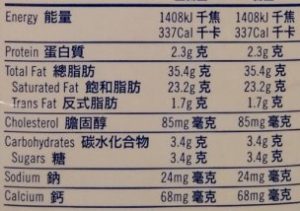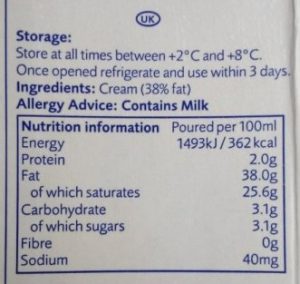After reading about the benefits of LCHF you may be contemplating it for yourself. But what exactly is a low carb, healthy fat lifestyle? What do you eat? What do you avoid? How long do you have to do it?
LCHF is not a diet
Eating LCHF is not a diet in the way most people think of a diet. You know, something you have to suffer long enough to get into your summer clothes, and then you go back to eating everything you were eating before the diet – and slowly put the weight back on again.
LCHF is a way of eating you can enjoy for the rest of your life – but it requires commitment.
- Commitment to do your homework and find out how LCHF will benefit you and your family.
- Commitment to stop eating some of the foods you’re eating now.
- Commitment to investing time shopping to find healthier alternatives, at least at the start.
- Commitment to prepare different meals.
Purpose of LCHF lifestyle
Refined carbohydrates, fruit juices, and drinks containing added sugar cause blood sugar to rise quickly. The body’s monitors sense the rising level of glucose and fructose and mechanisms are set in motion to reduce the levels as fast as possible.
To over-simply it, years of spiking sugar and insulin levels leads to weight gain, diabetes, heart disease, and all the other lifestyle diseases.
The LCHF way of eating rectifies that by removing the cause of the sugar and insulin spikes – processed carbohydrates, fruit juices, and sugary drinks.
Food groups
Apart from oxygen, there are four other macro-nutrients we need every day:
- Carbohydrates. When you change to LCHF food choices, you’ll automatically reduce carbohydrates by getting your carbs from leafy vegetables and salads, instead of starchy foods and sugary drinks.
- Fat. Fat intake will increase, because fats will become your energy source instead of glucose from refined carbohydrates and sugars.
- Protein. LCHF is not high protein. You’ll be eating low-to-moderate protein only.
- Water. Most people increase the amount of water they drink, especially when first changing to LCHF.
Technically speaking, carbohydrates are not an essential food. The liver can make any glucose our organs need, in a process called gluconeogenesis. The advantage of eating some carbohydrate from leafy vegetables and salads is the abundance on vitamins, minerals, antioxidants, and fibre they contain.
Is LCHF for everyone?
– Some people are able to eat carbohydrate-rich foods and not put on weight. They’re active and healthy.
My wife is an example of someone who can metabolise carbohydrates well. Heide makes her own bread, oat cookies, and occasional pizza; eats baked beans occasionally, and other pulses; enjoys a little red rice; the occasional potato, and fruit every day. That’s about 150 gm or more of carbohydrate each day.
I’m wired up differently and don’t seem to handle carbohydrate well, so I eat hardly any fruit, and none of the starches – my carbs are usually around 35 gm a day.
Our protein intake is similar at around 60-65 gm, and I eat much more fat than Heide does – 180-190 gm compared with her 40 gm or so.
As you can see from our personal examples, you can’t eat a lot of carbohydrate and a lot of fat. The fat replaces the starches and sugars you’re not eating.
– Some young and pre-menopausal women can experience alterations in their menstrual cycle if carbohydrates are very low, say only 20 gm a day. It’s not a reason to avoid LCHF altogether, just something to be aware of. A carb intake of 50 – 100 gm or so is fine for most women.
– Some overweight people are active and healthy, very content with their lives, and don’t feel the need to make changes.
– Although endurance athletes perform better burning fat, athletes requiring sudden bursts of energy, such as 100-metre sprinters, may need more glucose available (as stored glycogen).
Who benefits from LCHF?
** Overweight or obese people who are not happy with their lives, or have health challenges as a consequence of their weight, respond very well to restricting their refined carbohydrate and sugar consumption.
The LCHF lifestyle is the most effective way to lose weight.
** Many type 2 diabetics have benefited from the lower blood sugar and insulin levels an LCHF lifestyle affords, and many have been able to reduce, or even stop their medication.
** Type 1 diabetics are not able to come off insulin entirely, but often are able to reduce their basal dose of insulin and maintain a more stable blood glucose level from day to day.
** Because many types of cancer cells burn sugar for energy, a low carbohydrate lifestyle in conjunction with conventional treatment has the potential to make the conventional treatment more effective at a lower dose.
Also, LCHF is very effective in a particular type of brain cancer, and a growing number of cancer researchers are attempting to get the treatment protocols altered to accept LCHF as the first line of treatment.
There’s interest, too, in the potential of following an LCHF lifestyle to prevent cancer.
** LCHF is being used for people suffering from Alzheimer’s disease, dementia, or Parkinson’s disease, and is having very good results.
As with cancer, doctors are suggesting LCHF as a way of preventing these three brain diseases from occurring.
** LCHF is remarkably effective in reducing the frequency of epileptic seizures, especially in children. The Charlie Foundation does a lot of great work in this field.
** Inflammation is much lower when carbohydrates are restricted, which will benefit people with immune-type challenges like eczema, psoriasis, asthma, or allergies.
I can personally attest to this. The inflammation in my airways has reduced enough for me to stop taking antihistamine tablets and to stop using the Foracort inhaler 🙂
** Reducing inflammation will also reduce the risk of cardiovascular disease, and a host of other inflammation-driven conditions like arthritis.
The list of conditions improved by reducing inflammation is a very long one!
Basis of LCHF
The LCHF lifestyle is based on three tenets:
- Eat real, whole food.
- Eat when you are hungry.
- Eat until you are satisfied, then stop eating.
1. Eat real, whole food
Real whole food means food that has had the minimal amount of alteration, things added to it, or removed from it. That excludes most things in boxes, packets, foil bags, plastic bags, and tins.
Tinned fish is a possible exception, but read the ingredients on the label before you buy it. The sauces in some tinned fish have had sugar added to them, as well as modified starch, which is metabolised to sugar in the intestines.
For example, here’s a tinned fish I enjoy, because it contains tasty, real food: wild caught sardines, extra virgin olive oil, salt. Nothing else.


Read the labels
Reading the labels on food containers is part of that commitment I mentioned. It’s an investment that will pay you handsome dividends.
True, you’ll be longer in the supermarket for the first few visits, but you’ll soon learn which foods have additives you don’t want, and which foods you can take home to your family with confidence.
For example, earlier this week I wanted to buy some cream for my coffee. First time for years, so I started at one end of the cream shelf and began reading labels.
I was amazed at the difference between what is written and pictured on the fronts of the packs, compared with what is declared in the ingredients and nutritional information sections on the backs of the packs.
For example, this cream had emblazoned on the front of the carton ‘100% Australian Cream’. This is the back panel:


As you can see, the carton does contain cream. But it also has added milk, emulsifiers 471, 433, 472B, and thickener 407. And there’s trans fat listed, too.
How is that ‘100% Australian cream’? This box went back on the shelf. And so did several others with a similar ingredients list.
After five more minutes of reading, I put this one by Millac in the shopping trolley:

As you can see, the box contains cream – and nothing else. No E numbers added. And no trans fat. It’s wholesome, real food.
Well worth the time it took to find it. Now I can go straight to it next time.
2. Eat when you’re hungry, don’t eat if you’re not
Most of us eat by the clock. We eat breakfast at a certain time, have tea at a certain time, have lunch at a certain time, afternoon tea at a certain time, dinner at a certain time.
After starting with the LCHF food choices, the clock will become less and less important for regulating meal-times. Your feelings of hunger get less and less. You’ll find your mental concentration improves, and before you know it, you’ve been so engrossed in what you were doing you’ve missed lunch. Never mind. Only eat if you’re hungry.
You will also notice the need for snacks between meals disappears. That’s okay too. Have a snack if you’re hungry, don’t have one if you’re not.
3. Eat until satisfied then stop eating
Have you ever been to a buffet and found it irresistible to keep returning to the food? I have.
It’s as if an inner voice is whispering how much I would enjoy a helping of the delicious-looking food on the table in the corner. Often I’ve ignored the other inner voice from my stomach, telling me it’s already the size of an over-inflated beach ball, and I’ve gone to load up at that table I’ve not tried yet.
Eating low carb, healthy fat is not like that at all. That’s because you’ll be eating more healthy fat than you have previously, and maybe more green leafy vegetables and salads, too.
The healthy fat makes the meals more filling, the green leaves take longer to digest, and you don’t burn your meal away as quickly.
The feeling of satiety happens much sooner and lasts much longer, and you will simply feel full and stop eating. There are good biochemical reasons why this happens, which I’ll explain in another post.
Know your numbers
Do you know your HDL, LDL, and triglyceride levels? Or your blood sugar? How about your liver? Kidneys?
If you don’t know, consider asking your doctor for a blood test before you start the LCHF lifestyle. Then have it tested again a month or two after you’ve started LCHF so you can see the changes and confirm you’re on track for all the benefits.
You’ll find posts explaining blood tests in the category Blood tests and LCHF on the right of this page.
Briefly, most people see a large drop in their triglyceride level, a rise in their HDL level, and a decrease in the number of small dense LDL particles. These three changes mean a lower risk of cardiovascular disease. Blood pressure falls, too.
That reminds me. Please read the Medical Cautions page if you’re taking medicine for high blood pressure, diabetes, any other medical condition, or are expecting a baby.
What next?
Have a look at the posts in the category Starting the LCHF lifestyle for info and tips about how to get started on the LCHF healthy way of eating.
And if you have any questions, please put them in the comment box, below. I’ll be notified by email and get back to you asap.
